Right Bank: Hidden Treasures of Paris in Plain Sight, Part 2
- SUBSCRIBE
- ALREADY SUBSCRIBED?
BECOME A BONJOUR PARIS MEMBER
Gain full access to our collection of over 5,000 articles and bring the City of Light into your life. Just 60 USD per year.
Find out why you should become a member here.
Sign in
Fill in your credentials below.
Your first trip to Paris is most likely filled with a must-see list of all the big sites– Eiffel Tower, Arc de Triomphe, Sacré-Cœur, Musée du Louvre— and there is absolutely nothing wrong with that. After all, your whole life has been filled with images of these iconic monuments and the chance to see them up close is a dream come true. However, the beauty of Paris comes from the in-between moments. The walk through the Jardin des Tuileries on the way to the Louvre and the leisurely lunch sitting on a terrace watching Paris walk past… these are some of the very best things to do in the city. Slow down and savor the cobbled streets where famous authors and historical figures lived and keep an eye out for a hidden treasure.
We shall stay on the right bank on this little voyage, uncovering more of the little details with a big story that many will walk right past. We’ll start at the Place de la Concorde, sitting between the Jardin des Tuileries and the Champs Élysées where a large chapter of the bloody history of Paris once took place. It was called the Place de la Revolution when Louis XVI and Marie Antoinette lost their heads in the guillotine alongside 2,000 other people during the Reign of Terror. Have no fear; a quick name change in 1795 to the Place de la Concorde would hopefully wipe that image from people’s mind.

The sundial of Place de la Concorde. Photo: Claudine Hemingway
In 1833, Muhammad Ali Pasha, the ruler of Ottoman Egypt, gifted France with the 3000 year old Obelisk that once stood in front of the Luxor Temple. Pasha asked for only one thing in return: a clock. The obelisk itself is not the hidden treasure, but it plays a role in it. If you walk around the Place de la Concorde, as far as to the statues of the great cities of France, and look down, you may notice some Roman numerals on the ground. In 1913, the founder of the Société Astronomique de France and astronomer Camille Flammarion wanted to create the largest sundial in the world at this very spot. Plans were put in place using the 108 foot high Obelisk as a gnomon but postponed twice due to the World Wars. Flammarion would never see his vision come to life. In 1999, on the advent of the millennium, Philippe de la Cotardière and Denis Savoie– members of the Société Astronomique– presented the idea to the city of Paris. Mayor Jean Tiberi enthusiastically agreed and on June 21, 1999 he was present as the finished sundial was inaugurated. It was to remain until 2001, but just like the Eiffel Tower, it has fought past the hands of time. A few of the Roman numerals can still be seen, and on a clear sunny day, the Obelisk will help you find the time.

Lion by Giuseppe Franchi, Terrasse du Jeu-de-Paume, Luxor Obelisk. Photo: Yair Haklai/ Wikimedia Commons
Walk up to the north corner of the Jardin des Tuileries towards the Jeu du Paume. On the corner of the Terrasse de Jeu de Paume, overlooking the busy traffic of rue de Rivoli, stands a majestic lion. Placed in 1819, the neoclassical lion by Giuseppe Franchi has seen a thing or two in his time. It stands in front of the Jeu du Paume, today a museum but during WWII it was the warehouse for looted art that was sent to Germany. In August 1945 as the Liberation of Paris began, and the fighting intensified in the Place de la Concorde, the lion was struck by a German tank and tumbled down. If you look closely, you can see the cracks on his legs and tale where he was reassembled. At the base of where he stands, you can still see the bullet holes that riddled the Place de la Concorde: tangible history you can touch.
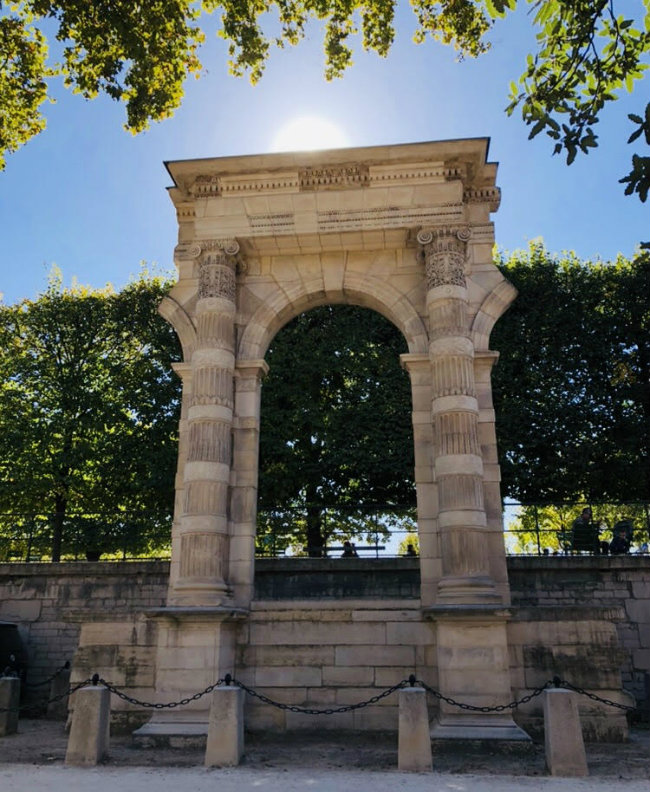
The remains of the Palais des Tuileries. Photo: Claudine Hemingway
Walking through the Tuileries, imagine the Queen mother Catherine de’ Medici looking out the windows of the Palais des Tuileries at the changing leaves. The palace she had built after the death of her husband King Henri II would open in 1564. The Renaissance palace was covered in regal symbolism on the columns and above the windows. It was Catherine’s way of rewriting the love story with her husband, emphasizing its significance over his true great love, his mistress Diane de Poitiers. Three hundred years of royalty would use the palace including Louis XIV and Marie Antoinette who would spend their final years of semi-freedom before prison. Napoleon Bonaparte would use the Palais des Tuileries as his official residence and would spend each night with a certain lady of the Louvre in his bedroom, the Mona Lisa.

The Tuileries Palace in 1860. Public domain
However, the grandness of the palace would end on 23 May 1871. It was the days of the Paris Commune and a dozen men set out, torches and gas in hand and set the Tuileries on fire. The ruins of the palace would stand for over 12 years– finally torn down in 1883. Although, we can still find a bit of the palace sprinkled throughout the city. You may never even know you walked past or sat on a bench on a lovely summer day in front of these historic remnants. On the southern side of the Jardin des Tuileries is a former arch, partially rebuilt that rises over the terrace that few people even notice. Other remains can be found inside the Musée du Louvre in the Cour Marly, in the Square Georges Cain, Académie des Beaux Arts and the Trocadero, far away from the hordes of people.
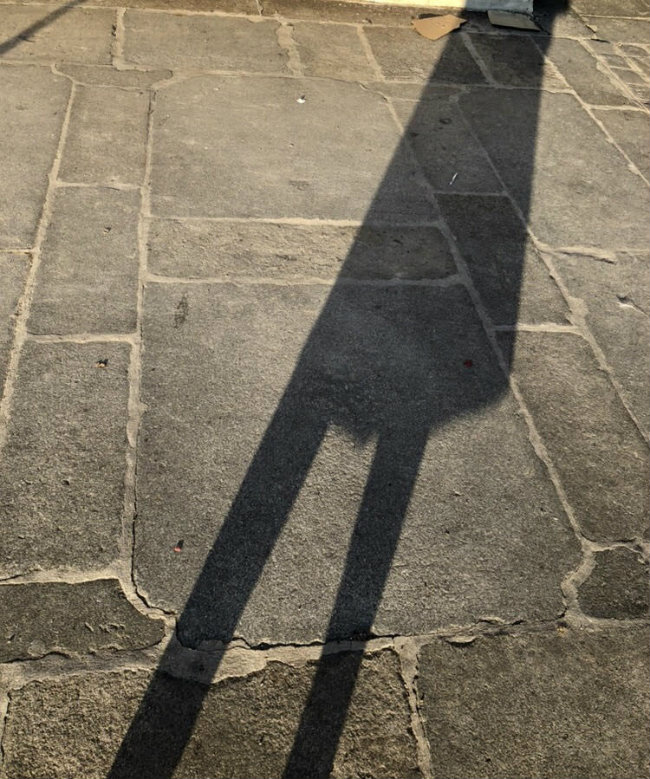
The initial H, for Henri IV, engraved in the stones. Photo: Claudine Hemingway
The Musée du Louvre and the palace that came before is decorated with the initials of the kings and emperors that each took part in its construction over 500 years. However, this little secret can be found at your feet outside the galleries. Out on the Quai François Mitterrand just as you walk under the Pavillon de Lesdiguières from the Place du Carousel as you wait for the light to change, look down. In the stones are the initials of two of the great builders of the Louvre. On the right is H for Henri IV and on the other side past the lanes of traffic is N for Napoleon III. Hard to spot when filled with people but hold back after the crossing and take a peek.
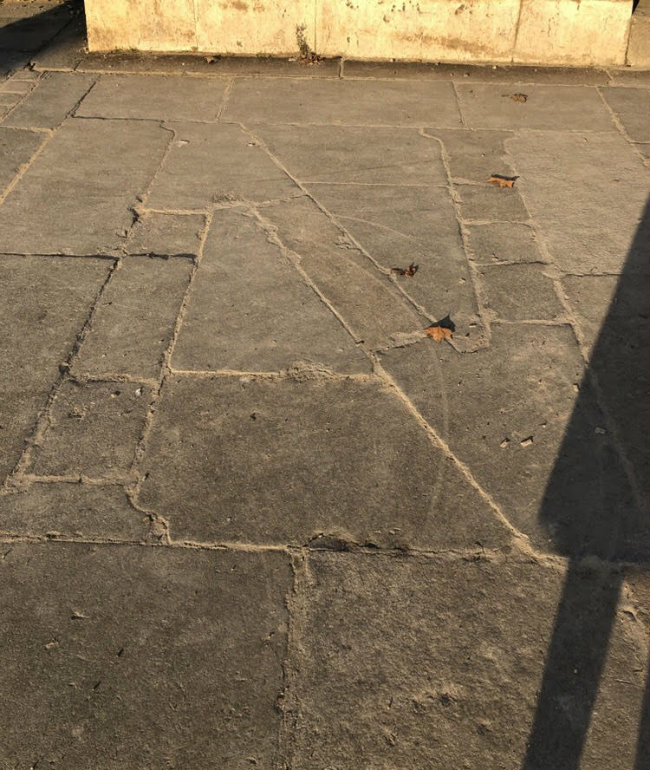
The initial N for Napoleon III in a Paris sidewalk. Photo: Claudine Hemingway
Speaking of Henri IV, our next find takes us over to the area once home to Les Halles market, known as “the Belly of Paris.” On Friday, May 14 1610, Henri IV was traveling by coach from the Louvre, wanting to see the procession of his wife Marie de Medici who was just crowned Queen of France the day before at Saint-Denis. Henri made his way from the Louvre to the very narrow Rue de la Ferronnerie and found it blocked by wagons carrying hay and wine barrels. While his men stepped off the coach to clear the traffic, the king was left unguarded long enough for François Ravaillac to jump onto the coach and stab the Vert Gallant with a stolen knife. As you walk down the street, keep your eyes down. Inlaid into the street at the spot at which he was killed is a stone with the crest of Henri IV, King of France and Navarre and the date of his death. He would die before he was able to return to the Louvre. Following his death, a wax effigy of the king would sit in the Salle des Caryatids for eleven days in June 1610. Lavish meals were served in front of him and members of his court sat in silence eating.
A short walk from Rue de la Ferronnerie is the Gothic masterpiece Saint Eustache that once overlooked Les Halles, the famed market that dates back to the 11th century when it started as a dry goods market. The food vendors moved in and it would be the central market of Paris until it was torn down in 1971. In 1476, La Corporation des Charcutiers, one of the most important organizations in France, was created blending history and gastronomy. While they may have been popular, they did go through some difficulties when rumors went around on what type of meet they butchered; I will leave it at that. Therefore, to win back their good name they would give back to the community and to the church of Saint Eustache. The first chapel on your left holds a very special set of stained glass windows donated by the guild in 1945. Look closely at it. The top holds the seal of Paris on the left and the coat of arms of the guild– depicting three sausages and a swine. Below, Saint Antoine, their patron saint, can be seen with a pig near his feet and to his left, a chef is presenting a tray of pork goodness to a church official. Only Paris would have a chapel dedicated to sausage, and rightfully so.
Just outside the doors of Saint Eustche through the Jardin Nelson-Mandela is a tall column topped with what looks like a cage. It was built by Jean Bullant under the instruction of Catherine de Medici. Catherine was a big believer in astrology and her advisors Como Ruggeri told her she would die near Saint-Germain. In the midst of building the Palais du Tuileries, near the Église St Germain l’Auxerrois, she stopped construction and abruptly moved to the Hôtel de Saissons near Saint-Eustache. The tall column built with a glass roof, which no longer remains, was connected to the Queen’s apartment so she could travel the 147 stairs to the top. The Hôtel de Saissons would be destroyed in 1748 and the Bourse du Commerce would be built in its place. It must have been a little Medici witchcraft that protected the column from being demolished. It remains today alongside the stock exchange, although currently covered and going through a renovation.
Tour de Jean Sans Peur in the second arrondissement is one of the few architectural remains of the Middle Ages. Built in 1409 and finished in 1411, the tower keep of the former Hôtel de Bourgogne is an often overlooked treasure that sits just off the busy Rue Étienne Marcel. After Jean sans peur (Jean the fearless) had his cousin Louis d’Orleans killed, he would take over the property and have a grand palais built to show his power and great wealth. Over the many years, the property passed through the hands of one noble after another and the land was divided. In 1866 on the heels of Haussmann’s rebuilding of Paris and construction of Rue Étienne Marcel, the remaining buildings were destroyed. The tower is all that remains of this once medieval palace. The good news is that you can visit, climbing each of its historic steps. Each floor has details of the former rooms and those that lived there. Make sure to look up, as you get closer to the final floor. The ceiling at the top of the tower is beautiful and looks like a tree that has grown from the center of the stairs reaching to the sky. It’s open Wednesday to Sunday in the afternoon only and frequently has special exhibits of life in the medieval times.
Long before Jean sans peur completed his palace and keep, it was once the location of the Hôtel d’Artois, built by Robert II, Count of Artois in 1270– sitting on the edge of the Philippe Auguste wall that encircles Paris. The wall was built between 1190 and 1290 by Philippe Auguste to protect Paris while he was off on crusades. Encircling over 625 acres and running a mile and a half on the right bank alone, the 20 to 25 foot high and three foot thick limestone walls kept the invaders out. On the right bank just behind the Saint-Paul-Saint-Louis church is the longest stretch of wall that remains today. On the Rue des Jardins-Saint Paul lining the large basketball court is almost 200 feet of ancient wall and a portion of the Tour Montgomery just outside the court. Walking by and seeing all the kids playing basketball, I constantly wonder if they know what that wall means and what it once was. Sitting in the third arrondissement, close to the center of all of Paris, this was once the outside of what we now know as the City of Light.
One of the many wonderful things in Paris is the accessibility to great art. With over 200 museums, there is no shortage of works by the many masters to see. However, did you know you could see many of these free? Hanging on the walls of the great churches of Paris you may come across a Le Brun, Reubens or even my favorite Delacroix. In the aftermath of the fire of Notre-Dame de Paris, a great collection of Les Mays paintings that were given to the church in the 17th and 18th centuries were thankfully saved and have been moved to the Musée du Louvre and will be on display later this year. If you have a keen eye, you will spot some of these masterpieces in other churches of Paris. In the Marais at the Saint-Denys-du-Saint-Sacrement, a quiet church void of visitors holds Delacroix’s first religious mural. In 1840, he was commissioned to paint the scene of La Pietà, the often-depicted scene of the Virgin holding the body of Christ. Working for months, he painted the frescos directly onto the wall of the chapel Saint Geneviève. The perfect practice before his grand project in Saint-Sulpice.
In its 10-year run, the French Revolution of the 18th century has left behind many stories. The end of Louis XVI and Marie Antoinette, the destruction of many historic buildings and furnishings and the rise of Napoleon Bonaparte. Of course, one of the most famous moments was on 14 July 1789, the day the Bastille prison was stormed. On the morning of July 14, a crowd of over a thousand men took to the Bastille. Demanding the release of the prisoners and gunpowder the crowd began to grow angrier as these demands were not met. Gunfire rang out and the fight began. Cutting the drawbridge, killing people beneath it when the Royal Army arrived. Over 100 people would die and in the end, the Bastille was emptied of all seven prisoners. Yes, you read that correctly, seven prisoners. It would take almost two years to dismantle the Bastille prison and the stones would be used around France including being carved into tiny replicas of the prison. Today in Paris, if you keep your eyes open you can find a few of these stones. In 1791, stones would be used to build the Pont de la Concorde. One hundred years later in 1899, while Paris was building the new Metro, the base of the Bastille would reappear and unearthed. Taken apart piece by piece it was moved just off the banks of the Seine at the Square Henri Galli. The tower base would be rebuilt among the foliage next to the busy Boulevard Henri IV.
Always keep an inquisitive eye open when walking through Paris, there are thousands of these wonderful remains that mark a point in time in the history of Paris. More to come on the left bank, à bientôt!
Lead photo credit : Place de la Concorde (at night). Photo: Esteban Chiner/ Flickr
More in hidden treasures, Right Bank
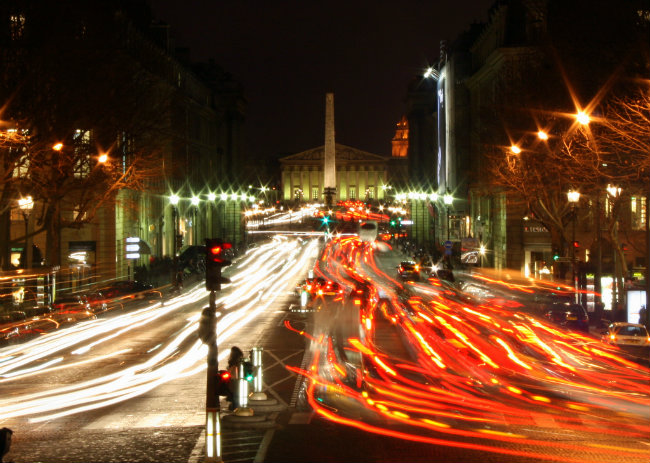

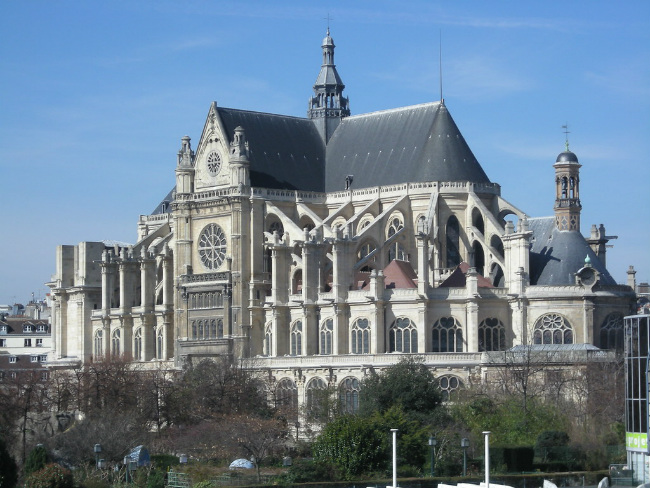
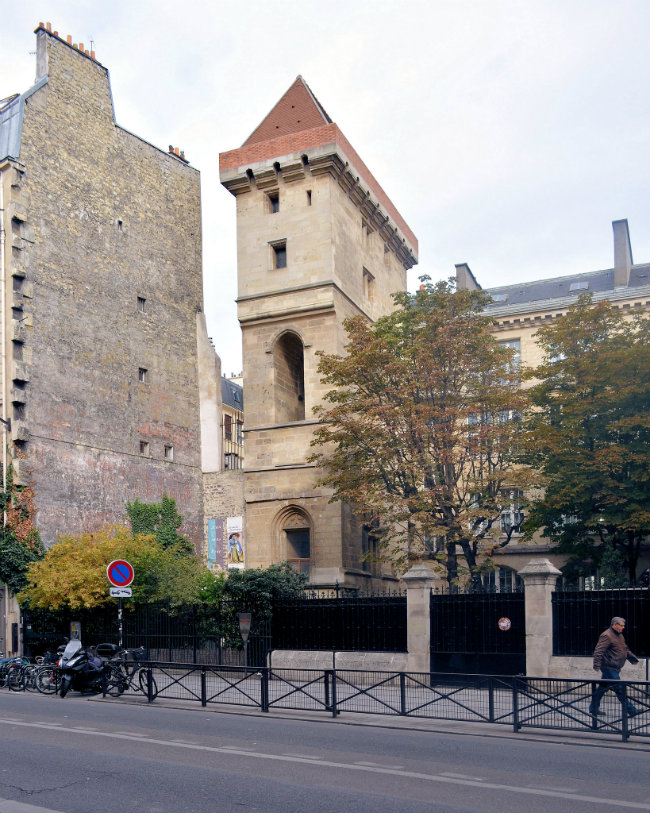



REPLY